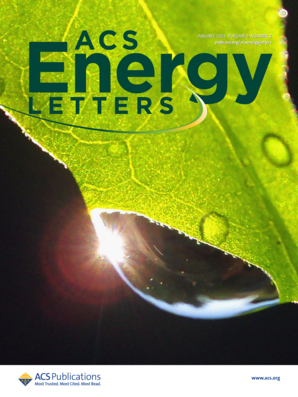茚二烯二噻吩桥接富勒烯抑制钙钛矿光伏中的缺陷
IF 19.3
1区 材料科学
Q1 CHEMISTRY, PHYSICAL
引用次数: 0
摘要
钙钛矿体界和晶界缺陷以及弱n型表面特性是制约钙钛矿太阳能电池(PSCs)功率转换效率(PCE)提高的关键因素。本文设计了一种受体-供体-受体(a - d - a)型有机钝化剂,其结构为两个C60笼夹在非富勒烯受体片段吲哚二噻吩[3,2-b]噻吩(IT)中,即C60-IT-C60。形态学和光谱测量表明,C60-IT-C60的IT单元和富勒烯笼中的S元素作为刘易斯碱和酸,钝化了不配位的Pb2+阳离子和阴离子缺陷。这种相互作用不仅使钙钛矿的能量图和功函数一致,而且促进了钙钛矿的结晶,抑制了钙钛矿的深、浅能级缺陷,导致PCE最大值为24.16%(填充因子为84.75%),提高了相应PSCs的存储性能和热稳定性。这项工作为PSCs中富勒烯衍生物的设计提供了一个新的范例。本文章由计算机程序翻译,如有差异,请以英文原文为准。
Indacenodithieno[3,2-b]thiophene-Bridged Fullerene for Defect Suppression in Perovskite Photovoltaics
Defects at the bulk and grain boundaries of perovskites, along with weak n-type surface characteristics, remain critical obstacles to enhance the power conversion efficiency (PCE) of the perovskite solar cells (PSCs). Herein, an acceptor–donor–acceptor (A-D-A) type organic passivator structured with two C60 cages sandwiching a nonfullerene acceptor fragment indacenodithieno[3,2-b]thiophene (IT), namely C60-IT-C60, is designed. Morphological and spectroscopic measurements demonstrate that the S element in the IT unit and the fullerene cages of C60-IT-C60 act as a Lewis base and acid to passivate the uncoordinated Pb2+ cation and anion defects. This interaction not only aligns the energy diagram and work functions of perovskite, but also encourages the crystallization of perovskite and suppresses the deep- and shallow-level defects, leading to a maximum PCE of 24.16% (fill factor of 84.75%) with improved storage and thermal stability in the corresponding PSCs. This work provides a new design paradigm of fullerene derivatives in PSCs.
求助全文
通过发布文献求助,成功后即可免费获取论文全文。
去求助
来源期刊

ACS Energy Letters
Energy-Renewable Energy, Sustainability and the Environment
CiteScore
31.20
自引率
5.00%
发文量
469
审稿时长
1 months
期刊介绍:
ACS Energy Letters is a monthly journal that publishes papers reporting new scientific advances in energy research. The journal focuses on topics that are of interest to scientists working in the fundamental and applied sciences. Rapid publication is a central criterion for acceptance, and the journal is known for its quick publication times, with an average of 4-6 weeks from submission to web publication in As Soon As Publishable format.
ACS Energy Letters is ranked as the number one journal in the Web of Science Electrochemistry category. It also ranks within the top 10 journals for Physical Chemistry, Energy & Fuels, and Nanoscience & Nanotechnology.
The journal offers several types of articles, including Letters, Energy Express, Perspectives, Reviews, Editorials, Viewpoints and Energy Focus. Additionally, authors have the option to submit videos that summarize or support the information presented in a Perspective or Review article, which can be highlighted on the journal's website. ACS Energy Letters is abstracted and indexed in Chemical Abstracts Service/SciFinder, EBSCO-summon, PubMed, Web of Science, Scopus and Portico.
 求助内容:
求助内容: 应助结果提醒方式:
应助结果提醒方式:


